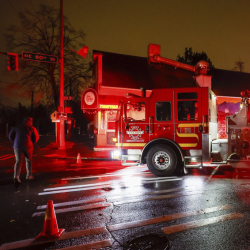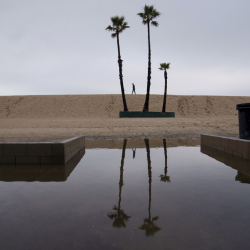 (CNN) -- Tropical Storm Isaac churned away in the Atlantic Ocean on Wednesday, forecast to strengthen into a hurricane and posing a potential threat to the GOP convention in Florida next week.
(CNN) -- Tropical Storm Isaac churned away in the Atlantic Ocean on Wednesday, forecast to strengthen into a hurricane and posing a potential threat to the GOP convention in Florida next week.
It's too early to tell what effects Isaac will have on the U.S. mainland. But several computer models bring the storm into the Gulf of Mexico, while others move it farther east over Florida.
With roughly 50,000 people headed to Tampa for the Republican National Convention starting Monday, there is heightened interest in the future path of the storm.
"We're monitoring the situation very closely," convention spokesman Kyle Downey said. "We are working closely with state, federal, and local officials and plan on putting on a great convention."
Tampa Mayor Bob Buckhorn said his city is prepared in case the storm comes its way.
"We have contingency plan after contingency plan," he said. "We are ready in the event that it happens. I don't think it's going to be a factor in this particular convention. But we are prepared in the event that it is."
At 11 a.m. ET, Isaac was about 140 miles (225 kilometers) east of Guadeloupe in the Leeward Islands with maximum sustained winds of 45 mph (72 kph) -- a slight increase from earlier in the morning -- and was moving west at 21 mph, the National Hurricane Center in Miami said.
Tropical storm warnings cover much of the Leeward Islands as well as Puerto Rico and the Virgin Islands.
A hurricane watch is in effect for Puerto Rico, the U.S. Virgin Islands and the Dominican Republic, which means hurricane conditions are possible within 48 hours.
"Strengthening is forecast during the next 48 hours ... and Isaac could become a hurricane by Thursday," the hurricane center said.
The center of the storm was forecast to move through the Leeward Islands on Wednesday evening, and to pass south of the Virgin Islands and Puerto Rico on Thursday, before approaching the Dominican Republic on Thursday night and into Friday, the hurricane center said.
Isaac could bring 4 to 8 inches of rain over the Northern Windward Islands and the Leeward Islands, the center said, and up to 6 inches of rain in some parts of Puerto Rico.
On the island of Hispaniola, home to the Dominican Republic and Haiti, 8 to 12 inches of rain, with maximum amounts of 20 inches, are possible, the center said.
Puerto Rico Gov. Luis Fortuno said the U.S. commonwealth has as many as 433 shelters ready to be activated by local mayors as the storm approaches. He said he expects rain from the system to reach Puerto Rico on Wednesday afternoon.
Aid organizations were keeping an eye on Haiti, where hundreds of thousands still live in camps after the deadly 2010 earthquake.
According to the United Nations High Commissioner for Refugees, 421,000 people are in camps in and around Port-au-Prince.
Isaac could be the first significant storm to hit Haiti since the devastating earthquake. Tropical Storm Emily threatened in 2011, but it weakened before hitting western Haiti.
"We watch those storms every single time they come near because Haiti is so vulnerable," said Amy Parodi, a spokeswoman for the Christian humanitarian organization World Vision.
The agency has met with the government in previous summers to discuss contingency plans for major storms, and pre-positioned relief items are available, she said.
Forecasters caution that the forecast track is uncertain and the storm could be anywhere from the Bahamas to the north and the Cayman Islands to the south on Sunday.
CNN's Dave Alsup, Allison Brennan, Kevin Liptak, Jason Hanna, Brad Lendon, Dave Hennen and Sean Morris contributed to this report.
Portland and Seattle
Free Subscription to Breaking News
Free Subscription to Breaking News






















































































































































































































































































































































